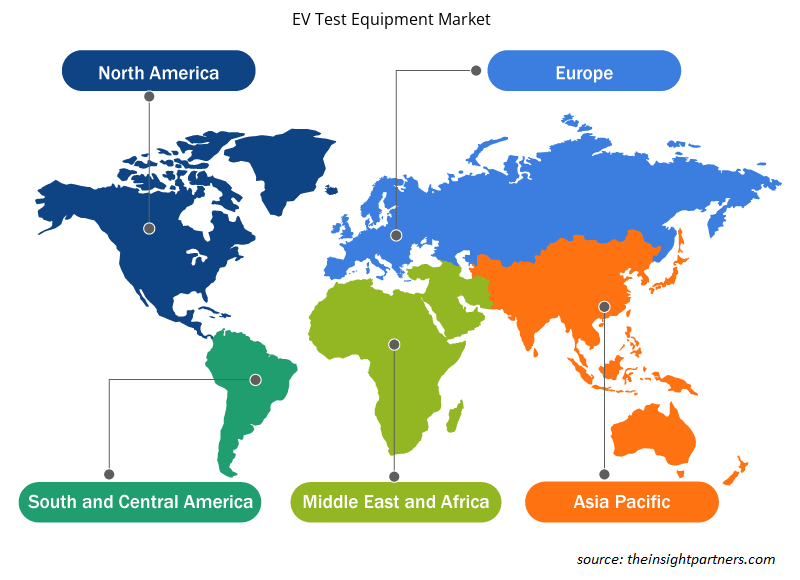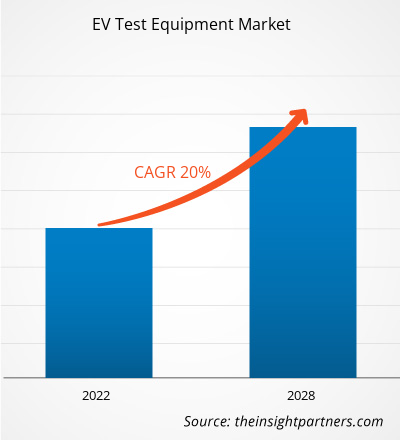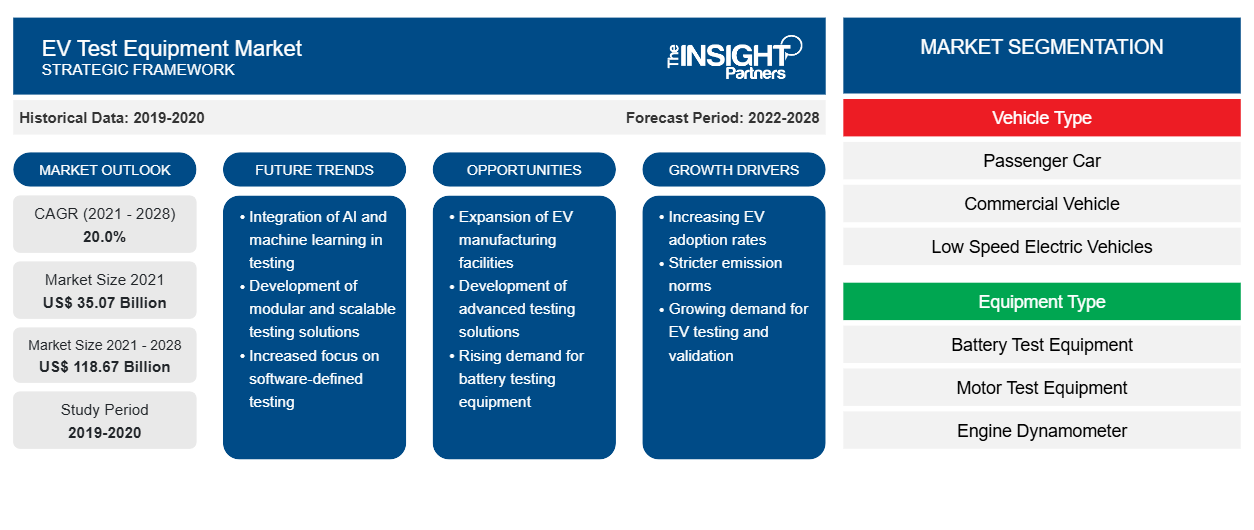Si prevede che il mercato delle apparecchiature di collaudo per veicoli elettrici crescerà da 35.072,54 milioni di dollari nel 2021 a 118.671,47 milioni di dollari entro il 2028; si stima che crescerà a un CAGR del 20,0% dal 2022 al 2028.
Le apparecchiature di prova per veicoli elettrici vengono utilizzate per ispezionare vari componenti dei veicoli elettrici, come batterie, motori e altri componenti, per mantenere i componenti automobilistici un passo avanti rispetto alla concorrenza, fornire prestazioni garantite e garantire la sicurezza e la soddisfazione del cliente. Le apparecchiature di prova vengono utilizzate nei veicoli elettrici per valutare le prestazioni totali del veicolo, i test della batteria e del caricabatterie dei veicoli elettrici , i test dell'elettronica di potenza e i test del motore e del dinamometro . Le apparecchiature di prova del motore vengono utilizzate per verificare la coppia o il segnale elettrico e l'alta velocità di un'auto elettrica, utilizzando sensori, sonde di tensione e altri software.
Le vendite di auto elettriche sono state incrementate dalla crescente domanda di veicoli a carburante alternativo e mobilità connessa. Per ridurre al minimo le emissioni e l'inquinamento automobilistico, diversi governi hanno adottato norme che incoraggiano l'uso di veicoli elettrici. Si prevede che il mercato delle apparecchiature di prova per veicoli elettrici si svilupperà a causa della crescente domanda di veicoli elettrici . Inoltre, tensioni più elevate consentono una ricarica più rapida, con conseguente adozione di batterie, trasmissioni e caricabatterie ad alte prestazioni. Di conseguenza, la domanda di apparecchiature e software di prova per veicoli elettrici è guidata dai progressi tecnologici nelle nuove tecnologie delle batterie, dalla crescente domanda di funzioni e caratteristiche elettroniche in un veicolo e dalle severe norme sulle emissioni.
Secondo EV-Volumes.com , il 2020 è stato un anno eccellente per i PHEV , con vendite globali di BEV e PHEV che hanno raggiunto i 3,2 milioni di unità. L'Europa ha immatricolato 1,4 milioni di veicoli elettrici nel 2020, in aumento del 137% rispetto al 2019, anche dopo l'emergere della pandemia di COVID-19. Questo aumento è stato notevolmente ampio per un mercato in calo del 20% anno su anno. Inoltre, l'Europa ha superato la Cina nel mercato dei veicoli elettrici per la prima volta dal 2015. Inoltre, molte aziende stanno riprendendo i servizi di trasporto pubblico, il che richiede l'implementazione di numerose misure e standard di sicurezza.
L'emergere di nuove soluzioni software, come le soluzioni digitali basate su cloud per la gestione della flotta in tempo reale e l'accelerazione nell'elettrificazione, sta plasmando il mercato globale delle apparecchiature di prova per veicoli elettrici . Ad esempio, il software di gestione della ricarica offerto da EVBox consente agli utenti di tracciare, gestire e ottimizzare la propria esperienza di guida di veicoli elettrici . Pertanto, per monitorare questo, le soluzioni di prova efficienti integrate con l'intelligenza artificiale saranno molto richieste nel periodo di previsione.
Personalizza questo report in base alle tue esigenze
Riceverai la personalizzazione gratuita di qualsiasi report, comprese parti di questo report, o analisi a livello nazionale, pacchetto dati Excel, oltre a usufruire di grandi offerte e sconti per start-up e università
-
Scopri le principali tendenze di mercato in questo rapporto.Questo campione GRATUITO includerà analisi di dati che spaziano dalle tendenze di mercato alle stime e alle previsioni.
Impatto della pandemia di COVID-19 sul mercato europeo delle apparecchiature di prova per veicoli elettrici
Lo scoppio del COVID-19 e il percorso verso la ripresa hanno avuto vari impatti sulle reti stradali. Nel 2020 si è registrato un aumento nell'acquisto di apparecchiature di prova per veicoli elettrici in tutta Europa. Ad esempio, Germania, Francia e Italia hanno registrato vendite di auto elettriche in Europa superiori del 55% durante la prima metà del 2020 rispetto al 2019. La crescita del mercato delle apparecchiature di prova per veicoli elettrici in Europa è dovuta alla crescente necessità dei produttori di conformarsi agli standard più severi dell'Unione Europea sulle emissioni di CO2 per le nuove autovetture e i furgoni a partire da gennaio 2020. Il VDE Institute con sede in Germania è specializzato in scienza, standardizzazione, test di prodotto, certificazione e consulenza applicativa. Nel 2019, il VDE Institute è stato nominato servizio tecnico di categoria A, B e D dalla Federal Motor Vehicle Transport Authority, che gli consente di eseguire test sui veicoli elettrici in base al Highway Traffic Act, al Vehicle Parts Act e ai regolamenti secondo l'Accordo della Commissione economica per le Nazioni Unite per l'Europa ( regolamenti ECE ). I test e la certificazione eseguiti dal VDE Institute garantiscono una mobilità senza problemi e la sicurezza dei dati nel sistema complessivo, che include l'infrastruttura di ricarica, le stazioni di ricarica e le wall box durante la fase di sviluppo iniziale di un prodotto per i test di approvazione finale (validazione). La presenza di un ampio mercato di veicoli elettrici , istituzioni con decenni di esperienza nei test di sicurezza elettrica e crescenti requisiti per testare i componenti elettronici integrati nel veicolo stanno spingendo la crescita del mercato delle apparecchiature di prova per veicoli elettrici in Europa.
Approfondimenti sul mercato delle apparecchiature di prova per veicoli elettrici
Le aziende di stazioni di ricarica per veicoli elettrici stanno sviluppando tecnologie innovative per stazioni di ricarica come turbocharger, terra HP charging, sistemi di ricarica intelligenti, trasmissione di potenza wireless e caricabatterie bidirezionali . Tali progressi nei sistemi di ricarica per veicoli elettrici richiedono tecniche di collaudo migliorate. I sistemi di collaudo per stazioni di ricarica per veicoli elettrici sono disponibili presso aziende tra cui ROLEC , DEKRA e TUV Rheinland . La ricarica intelligente è uno dei sistemi di ricarica più avanzati. La ricarica intelligente consente il bilanciamento del carico e la distribuzione proporzionale della capacità di potenza disponibile su tutte le stazioni di ricarica attive. Facilita inoltre la raccolta di dati di ricarica critici da varie stazioni utilizzando un'unica piattaforma di gestione basata su cloud.
Approfondimenti di mercato basati sul tipo di veicolo
In base al tipo di veicolo, il mercato delle apparecchiature di prova per veicoli elettrici è suddiviso in autovetture, veicoli commerciali e veicoli elettrici a bassa velocità . Nel 2021, il segmento delle autovetture ha rappresentato la quota di mercato più ampia delle apparecchiature di prova per veicoli elettrici .
Approfondimenti di mercato basati sul tipo di apparecchiatura
In base al tipo di apparecchiatura, il mercato delle apparecchiature di prova per veicoli elettrici è suddiviso in apparecchiature di prova per batterie, apparecchiature di prova per motori, dinamometro per motori, dinamometro per telai , dinamometro per trasmissioni , tester per pompe di iniezione del carburante, tester per inverter, test di trasmissione per veicoli elettrici , caricabatterie di bordo, AC/DC EVSE . Nel 2021, il segmento delle apparecchiature di prova per batterie ha rappresentato la quota di mercato maggiore delle apparecchiature di prova per veicoli elettrici .
Approfondimenti di mercato basati sulle applicazioni
In base all'applicazione, il mercato delle apparecchiature di prova per veicoli elettrici è segmentato in sistemi di componenti e trasmissioni per veicoli elettrici, ricarica per veicoli elettrici e gruppo propulsore. Nel 2021, il segmento del gruppo propulsore ha rappresentato la quota di mercato più ampia delle apparecchiature di prova per veicoli elettrici.
Approfondimenti di mercato basati sugli utenti finali
In base agli utenti finali, il mercato delle apparecchiature di prova per veicoli elettrici è suddiviso in OEM, fornitori di livello 1, ricerca e accademici, altri. Nel 2021, il segmento dei fornitori di livello 1 ha rappresentato la quota di mercato più ampia delle apparecchiature di prova per veicoli elettrici.
Gli operatori di mercato adottano strategie quali fusioni, acquisizioni e iniziative di mercato per mantenere le loro posizioni nelle previsioni di mercato delle apparecchiature di prova per veicoli elettrici. Di seguito sono elencati alcuni sviluppi dei principali operatori nel report di mercato delle apparecchiature di prova per veicoli elettrici:
- Il lancio dell'Engineering Innovation Centre (EIC) di NI a Bangalore è stato annunciato a marzo 2022. La struttura di ingegneria aiuterà i clienti, i partner e le startup di NI che servono il settore aerospaziale e militare locale. L'EIC sarà anche utilizzato per insegnare alla prossima generazione di ingegneri nei settori aerospaziale e militare la comprensione del sistema.
- Nel 2021, Keysight Technologies, Inc. e Proventia Oy hanno collaborato per sviluppare soluzioni di test per batterie per veicoli elettrici (EV). La partnership tra Keysight e Proventia si traduce in una struttura di test sicura e indipendente dalla posizione che può essere implementata rapidamente.
Approfondimenti regionali sul mercato delle apparecchiature di prova per veicoli elettrici
Le tendenze regionali e i fattori che influenzano il mercato delle apparecchiature di prova per veicoli elettrici durante il periodo di previsione sono stati ampiamente spiegati dagli analisti di Insight Partners. Questa sezione discute anche i segmenti e la geografia del mercato delle apparecchiature di prova per veicoli elettrici in Nord America, Europa, Asia Pacifico, Medio Oriente e Africa e America meridionale e centrale.

- Ottieni i dati specifici regionali per il mercato delle apparecchiature di prova per veicoli elettrici
Ambito del rapporto di mercato sulle apparecchiature di prova per veicoli elettrici
| Attributo del report | Dettagli |
|---|---|
| Dimensioni del mercato nel 2021 | 35,07 miliardi di dollari USA |
| Dimensioni del mercato entro il 2028 | 118,67 miliardi di dollari USA |
| CAGR globale (2021 - 2028) | 20,0% |
| Dati storici | 2019-2020 |
| Periodo di previsione | 2022-2028 |
| Segmenti coperti |
Per tipo di veicolo
|
| Regioni e Paesi coperti |
America del Nord
|
| Leader di mercato e profili aziendali chiave |
|
Densità degli operatori del mercato delle apparecchiature di prova per veicoli elettrici: comprendere il suo impatto sulle dinamiche aziendali
Il mercato delle apparecchiature di prova per veicoli elettrici sta crescendo rapidamente, spinto dalla crescente domanda degli utenti finali dovuta a fattori quali l'evoluzione delle preferenze dei consumatori, i progressi tecnologici e una maggiore consapevolezza dei vantaggi del prodotto. Con l'aumento della domanda, le aziende stanno ampliando le loro offerte, innovando per soddisfare le esigenze dei consumatori e capitalizzando sulle tendenze emergenti, il che alimenta ulteriormente la crescita del mercato.
La densità degli operatori di mercato si riferisce alla distribuzione di aziende o società che operano in un particolare mercato o settore. Indica quanti concorrenti (operatori di mercato) sono presenti in un dato spazio di mercato in relazione alle sue dimensioni o al valore di mercato totale.
Le principali aziende che operano nel mercato delle apparecchiature di prova per veicoli elettrici sono:
- Società nazionale di strumenti
- Società per azioni Horiba Ltd.
- Strumenti Arbin
- Società per azioni Maccor Inc.
- TECNOLOGIE KEYSIGHT, INC.
Disclaimer : le aziende elencate sopra non sono classificate secondo un ordine particolare.

- Ottieni una panoramica dei principali attori del mercato delle apparecchiature di prova per veicoli elettrici
Profili aziendali
- Società nazionale di strumenti
- Horiba Ltd
- Strumenti Arbin
- Maccor Inc
- TECNOLOGIE KEYSIGHT, INC.
- Froude, Inc
- Controlli Dynomerk
- Comemso elettronica GmbH
- Gruppo Dürr
- TÜV Renania
- GRUPPO INTERTEK PLC
- TOYO SYSTEM CO., LTD
- Società a responsabilità limitata WONIK PNE CO., LTD.
- Analisi storica (2 anni), anno base, previsione (7 anni) con CAGR
- Analisi PEST e SWOT
- Valore/volume delle dimensioni del mercato - Globale, Regionale, Nazionale
- Industria e panorama competitivo
- Set di dati Excel
Report recenti
Testimonianze
Motivo dell'acquisto
- Processo decisionale informato
- Comprensione delle dinamiche di mercato
- Analisi competitiva
- Analisi dei clienti
- Previsioni di mercato
- Mitigazione del rischio
- Pianificazione strategica
- Giustificazione degli investimenti
- Identificazione dei mercati emergenti
- Miglioramento delle strategie di marketing
- Aumento dell'efficienza operativa
- Allineamento alle tendenze normative























 Ottieni un campione gratuito per - Mercato delle apparecchiature di prova per veicoli elettrici
Ottieni un campione gratuito per - Mercato delle apparecchiature di prova per veicoli elettrici